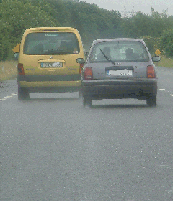Teaching overtaking
During driving tests overtaking manoeuvres must be well planned and completed safely, this includes overtaking of cyclists, mobility scooters, street-cleaning and other relatively slow moving vehicles.
If the test includes dual-carriageways it might be necessary to overtake in order to make progress at an acceptable speed.
 Your learners need to understand the questions to ask in order to determine whether or not an overtake would be worthwhile and safe. These include:
Your learners need to understand the questions to ask in order to determine whether or not an overtake would be worthwhile and safe. These include:
-
Is it necessary to overtake?
-
Is this a safe location?
-
How will the manoeuvre affect other drivers?
-
Is there sufficient space to overtake within the speed limit?
The DriverActive Visual Teaching System shows a step-by-step method overtaking. This method is also explained on the DriverActive web site and in the SmartDriving Driver's area (referenced on the first page of this section).
Depending on the lesson that you have chosen to teach for Part-Three an opportunity or need for overtaking might arise. If you are teaching a learner who is 'up to the task' or a full licence holder the examiner might expect to see an overtake - especially where failing to overtake would result is a significant lack of progress causing problems for other drivers.
If you are teaching an out-of-town lesson it will often be appropriate to discuss overtaking, especially to discuss places where it might or might not be safe to overtake (whether or not the lesson includes opportunities for overtaking). You must also be skilled in order to demonstrate overtaking if and when it is necessary.
We do not have detailed teaching information for overtaking, simply because if you are skilled in the subject yourself and have gained the general teaching skills explained in this course you should be able to construct a lesson fairly easily.
Tips:
Cover the basics of overtaking whenever an opportunity arises to pass cyclists.
When doing a dedicated overtaking lesson start on a dual-carriageway. By doing this you can cover the technique safely without the risks posed by approaching traffic. After the method has been learned on a dual-carriageway you can transfer the skill to a two-way road.
Next: Step 3 - Overtaking issues...